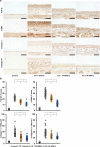Mesenchymal stem cells cultured in serum-free medium ameliorate experimental peritoneal fibrosis
- PMID: 33757592
- PMCID: PMC7986267
- DOI: 10.1186/s13287-021-02273-1
Mesenchymal stem cells cultured in serum-free medium ameliorate experimental peritoneal fibrosis
Abstract
Background: Mesenchymal stem cells (MSCs) provide potential treatments for peritoneal fibrosis. However, MSCs cultured in media containing serum bring risks of infection and other problems. In this study, we compared the effect of human MSCs in serum-free medium (SF-MSCs) on peritoneal fibrosis with that of MSCs cultured in medium containing 10% fetal bovine serum (10%MSCs).
Methods: Peritoneal fibrosis was induced by intraperitoneally injecting 0.1% chlorhexidine gluconate (CG). SF-MSCs or 10%MSCs were intraperitoneally administered 30 min after the CG injection. Ten days after the CG and MSC injections, we performed histological analyses and peritoneal equilibrium testing. In the in vitro experiments, we used transforming growth factor (TGF)-β1-stimulated human peritoneal mesothelial cells incubated in conditioned medium from MSCs to examine whether the SF-MSCs showed enhanced ability to produce antifibrotic humoral factors.
Results: Histological staining showed that the SF-MSCs significantly suppressed CG-induced cell accumulation and thickening compared with that of the 10%MSCs. Additionally, the SF-MSCs significantly inhibited mesenchymal cell expression, extracellular matrix protein deposition and inflammatory cell infiltration. Peritoneal equilibration testing showed that compared with administering 10%MSCs, administering SF-MSCs significantly reduced the functional impairments of the peritoneal membrane. The in vitro experiments showed that although the conditioned medium from MSCs suppressed TGF-β1 signaling, the suppression did not significantly differ between the SF-MSCs and 10%MSCs.
Conclusions: Serum-free culture conditions can enhance the antifibrotic abilities of MSCs by suppressing inflammation. Administering ex vivo expanded SF-MSCs may be a potential therapy for preventing peritoneal fibrotic progression.
Keywords: Immunosuppression; Mesenchymal stem cells; Peritoneal dialysis; Peritoneal fibrosis; Serum-free culture condition.
Conflict of interest statement
The Department of Stem Cell Biology and Medicine, Graduate School of Biomedical & Health Sciences, Hiroshima University, is a collaborative research laboratory funded by TWOCELLS Company, Limited. Emeritus Prof. Kato is the vice president of TWOCELLS Company, Limited. All remaining authors have declared that no conflicts of interest exist.
Figures






Similar articles
-
Mesenchymal stem cells ameliorate experimental peritoneal fibrosis by suppressing inflammation and inhibiting TGF-β1 signaling.Kidney Int. 2013 Aug;84(2):297-307. doi: 10.1038/ki.2013.81. Epub 2013 Mar 13. Kidney Int. 2013. PMID: 23486522 Free PMC article.
-
Serum-free medium and hypoxic preconditioning synergistically enhance the therapeutic effects of mesenchymal stem cells on experimental renal fibrosis.Stem Cell Res Ther. 2021 Aug 23;12(1):472. doi: 10.1186/s13287-021-02548-7. Stem Cell Res Ther. 2021. PMID: 34425892 Free PMC article.
-
Serum-Free Medium Enhances the Immunosuppressive and Antifibrotic Abilities of Mesenchymal Stem Cells Utilized in Experimental Renal Fibrosis.Stem Cells Transl Med. 2018 Dec;7(12):893-905. doi: 10.1002/sctm.17-0284. Epub 2018 Sep 30. Stem Cells Transl Med. 2018. PMID: 30269426 Free PMC article.
-
Efficacy of mesenchymal stem cells in the treatment of peritoneal fibrosis in animal models: a systematic review and meta-analysis.Ren Fail. 2024 Dec;46(2):2438863. doi: 10.1080/0886022X.2024.2438863. Epub 2024 Dec 16. Ren Fail. 2024. PMID: 39681477 Free PMC article.
-
Clinical and preclinical studies of mesenchymal stem cells to alleviate peritoneal fibrosis.Stem Cell Res Ther. 2024 Jul 30;15(1):237. doi: 10.1186/s13287-024-03849-3. Stem Cell Res Ther. 2024. PMID: 39080683 Free PMC article. Review.
Cited by
-
Peritoneal fibrosis: from pathophysiological mechanism to medicine.Front Physiol. 2024 Sep 4;15:1438952. doi: 10.3389/fphys.2024.1438952. eCollection 2024. Front Physiol. 2024. PMID: 39301425 Free PMC article. Review.
-
VX-509 attenuates the stemness characteristics of colorectal cancer stem-like cells by regulating the epithelial-mesenchymal transition through Nodal/Smad2/3 signaling.World J Stem Cells. 2024 Feb 26;16(2):207-227. doi: 10.4252/wjsc.v16.i2.207. World J Stem Cells. 2024. PMID: 38455101 Free PMC article.
-
Extracellular Vesicles Derived from Adipose Mesenchymal Stem Cells Promote Peritoneal Healing by Activating MAPK-ERK1/2 and PI3K-Akt to Alleviate Postoperative Abdominal Adhesion.Stem Cells Int. 2022 May 5;2022:1940761. doi: 10.1155/2022/1940761. eCollection 2022. Stem Cells Int. 2022. PMID: 35578661 Free PMC article.
-
Current Insights into Cellular Determinants of Peritoneal Fibrosis in Peritoneal Dialysis: A Narrative Review.J Clin Med. 2023 Jun 30;12(13):4401. doi: 10.3390/jcm12134401. J Clin Med. 2023. PMID: 37445436 Free PMC article. Review.
-
Astragalus polysaccharides augment BMSC homing via SDF-1/CXCR4 modulation: a novel approach to counteract peritoneal mesenchymal transformation and fibrosis.BMC Complement Med Ther. 2024 May 24;24(1):204. doi: 10.1186/s12906-024-04483-5. BMC Complement Med Ther. 2024. PMID: 38789949 Free PMC article.
References
-
- Liyanage T, Ninomiya T, Jha V, Neal B, Patrice HM, Okpechi I, Zhao MH, Lv J, Garg AX, Knight J, Rodgers A, Gallagher M, Kotwal S, Cass A, Perkovic V. Worldwide access to treatment for end-stage kidney disease: a systematic review. Lancet. 2015;385(9981):1975–1982. doi: 10.1016/S0140-6736(14)61601-9. - DOI - PubMed
-
- Williams JD, Craig KJ, Topley N, Von Ruhland C, Fallon M, Newman GR, et al. Morphologic changes in the peritoneal membrane of patients with renal disease. J Am Soc Nephrol. 2002;13(2):470–479. - PubMed
-
- Margetts PJ, Churchill DN. Acquired ultrafiltration dysfunction in peritoneal dialysis patients. J Am Soc Nephrol. 2002;13(11):2787–2794. - PubMed
Publication types
MeSH terms
Substances
LinkOut - more resources
Full Text Sources
Other Literature Sources
Research Materials

